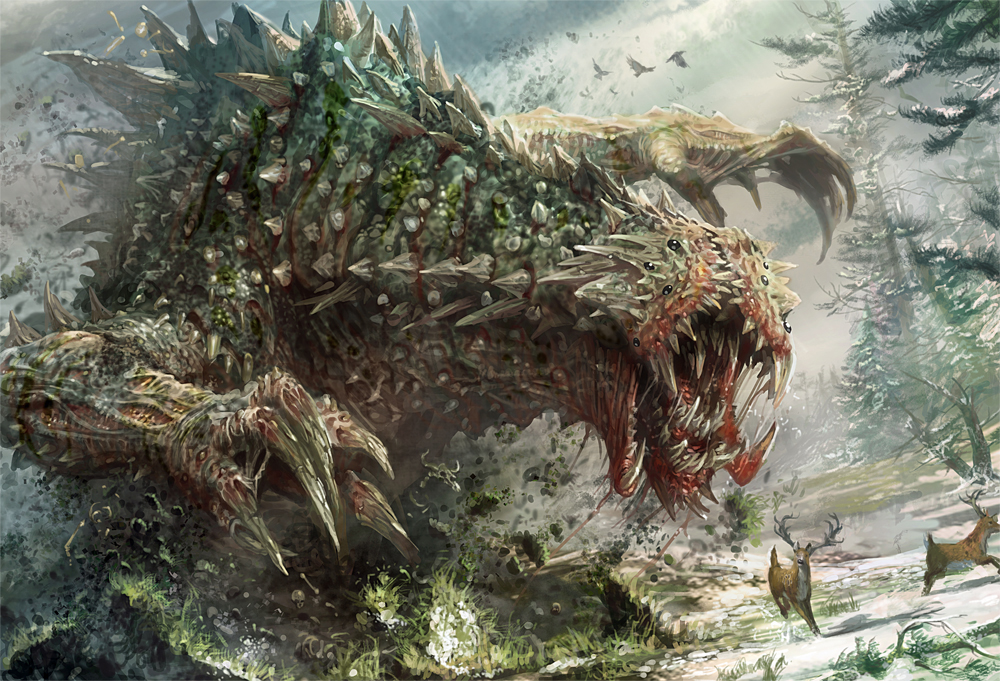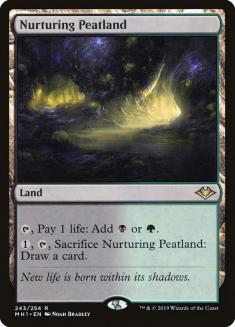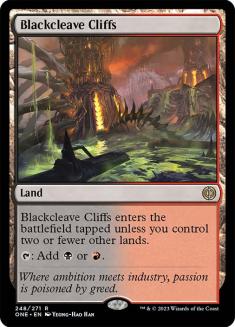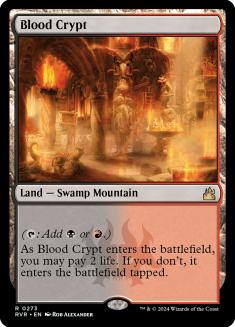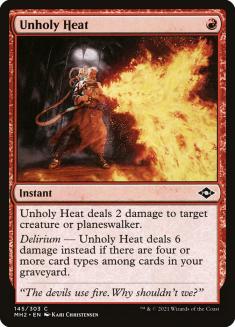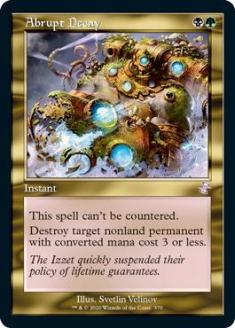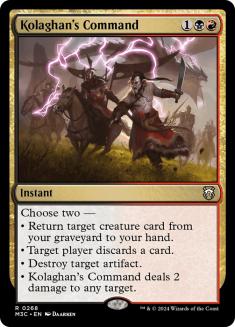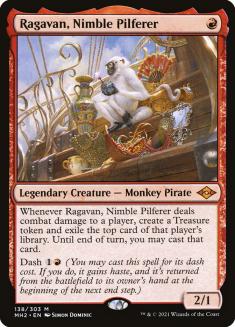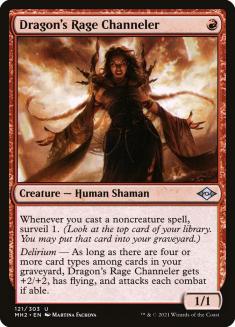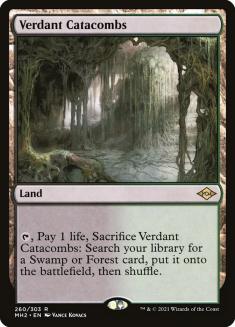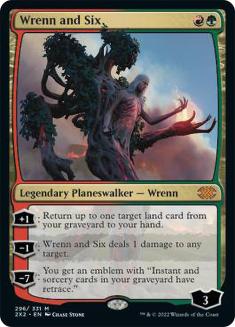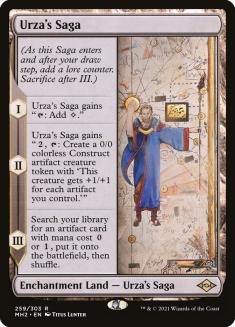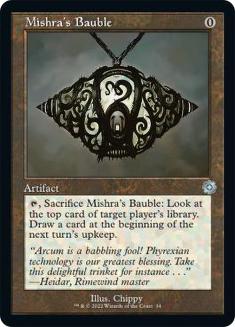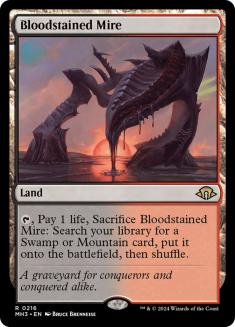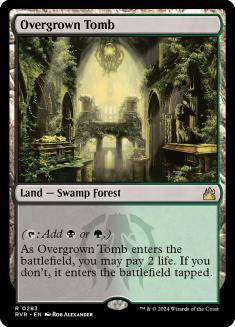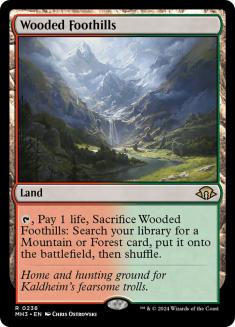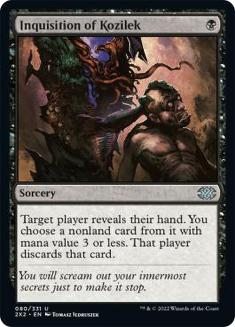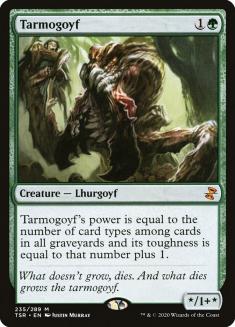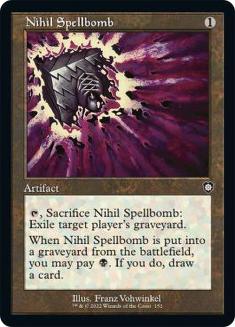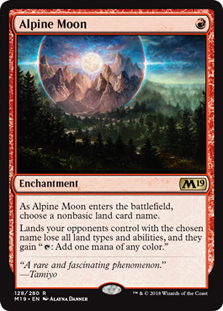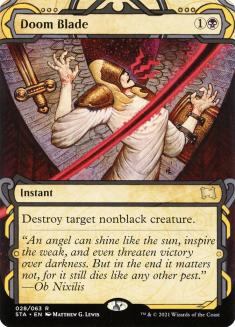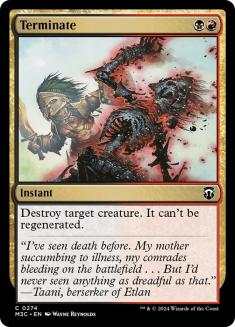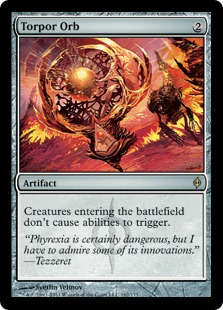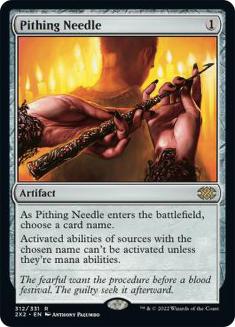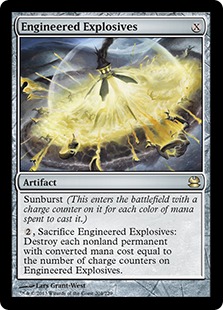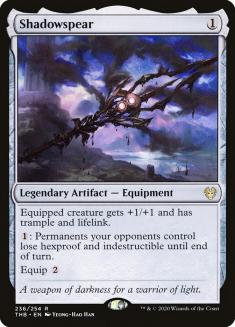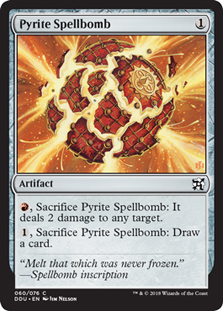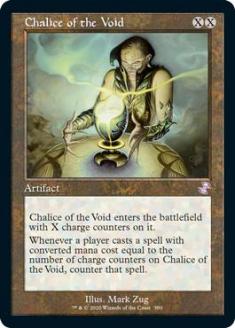It’s finally time! Today we talk about the best deck in Modern — Jund Midrange (Lurrus).
Sure, it might not win the most, nor do any high-profile Modern streamers ever play it, but that stuff doesn’t really matter to me. What’s really important is those that choose to wield the red, black and greed do so with pride. We strive to take the road less traveled so that when we beat them, and we know we will, they’ll say to us that which feeds our soul:
My goal for this article is not to feed my Jund brothers and sisters fish for a day. That’d be too easy. No, I’m here to bestow upon you a lifetime of midrange knowledge so that you can craft the tools necessary to continue winning for months or even years to come. That, or until Wizards of the Coast (WotC) bans Ragavan.
Today’s article will be broken into sections as we discuss:
- The manabase
- Maindeck removal suite
- What’s the play: Ragavan or Dragon’s Rage Channeler
- Sideboard construction and philosophy
- My current build
- Sideboarding (aka feeding my brothers and sisters fish for the day)
The Manabase
For the most part, the Jund Midrange (Lurrus) manabase has become homogenized with:
- 10-11 fetchlands
- 3-4 shocklands
- 2-3 Blackcleave Cliffs
- 4 Urza’s Saga
- 3 basic lands
- 0-1 Nurturing Peatland
My preferred combination is the following:
- 10 fetchlands
- 4 shocklands
- 2 Blackcleave Cliffs
- 4 Urza’s Saga
- 3 basic lands
- 0 Nurturing Peatland
I just don’t like Nurturing Peatland in the deck. It takes up a slot that could go towards Blackcleave Cliffs or my preferred second Blood Crypt. It’s also at its best when you have Wrenn and Six on the battlefield, but I’d much rather be returning Urza’s Saga to my hand. Sometimes it will be nice when you can draw a card you’ve seen with a Dragon’s Rage Channeler, but that rarely comes up.
The biggest reason I dislike this land is because it adds another non-red source to the deck. The deck already runs four copies of Urza’s Saga, a Forest, a Swamp, and an Overgrown Tomb. A Nurturing Peatland drops you down to fifteen red sources which, to me, is just too low for the value it provides the deck.
I personally like having a second Blood Crypt which gets you up to seven fetchable sources of mana. This rarely matters, but does have value in slower matchups when you’re trying to put Lurrus in your hand and cast it on the same turn. This is often how I try to play my “Thoughtseize mirrors” when I can.
Now if Boros Burn is popular, I would consider a third Blackcleave Cliffs over the second Blood Crypt. That said, I don’t think it’s the most difficult of matchups to begin with, but it’s a defensible argument for why you’d want to play three Blackcleave Cliffs and one Blood Crypt.
Maindeck Removal Suite
There are a few golden rules I apply whenever I’m fixing my maindeck removal suite.
The first is simple: don’t fold to Chalice of the Void. It’s a pretty easy rule to forget when you’re trying to finalize your list, so try not to forget. I’ll play as few as two maindeck ways to destroy a Chalice of the Void, and four in the entire 75, ignoring Engineered Explosives. My favorite mixture is two Abrupt Decay in the maindeck with a third in the sideboard along with the Kolaghan’s Command. If I want a fifth way, I’ll add a second Kolaghan’s Command to the maindeck. If I feel safe with just three, I’ll remove the sideboard copy of Abrupt Decay.
The next rule I try to apply is having access to more than two unique one-mana value removal spells. This means I’m not interested in four copies of Unholy Heat and then either two copies of Fatal Push or Lightning Bolt. The reasoning behind this is simple; I believe drawing a combination of unique spells will often be better than multiples of one.
Fatal Push has been nice with the resurgence of Grixis Death’s Shadow (Lurrus) so I’ll likely play two copies of it when that deck’s popular. Besides that though, I’ll typically just run one copy.
It felt counterintuitive to play two copies of Lightning Bolt when I was most scared of Omnath decks, but surprisingly the card’s very good here. In the early turns of the game it’s the only removal spell that can break up Ephemerate shenanigans on either Fury or Solitude. Later on it’s sometimes involved in your path to victory as inevitability isn’t on your side. You’re the aggressor in these matchups, making Lightning Bolt a potential way to finish the game. This sounded silly to me but came up in practice several times.
Unholy Heat feels like the biggest mistake in Modern Horizons 2. It’s just too damn efficient! Like, how does WotC top the printing of this card? They can’t, really, and we’ll forever see this card be the go-to removal spell in decks like Jund Midrange and Grixis Death’s Shadow.
That said, I do not think you need to play four copies. Like I said earlier, I’m always nervous about drawing two copies of the same card when they’re bad, and this is one of the main culprits for that rule. Sometimes you can’t get delirium fast enough or there aren’t any targets for removal spells. Regardless of the actual situation, there will be times you just don’t want two copies in your hand.
My Go-To Combination
If, for whatever reason, I decide to play more than six copies of these spells, I’ll add the fourth Unholy Heat. The only time I believe that would be correct would be when creature decks are heavily played, so drawing multiples of them would be important.
What’s the Play: Ragavan or Dragon’s Rage Channeler?
One of the more interesting decisions in Jund Midrange (Lurrus) is whether to cast Ragavan, Nimble Pilferer or Dragon’s Rage Channeler on Turn 1. So for this exercise, we’re going to imagine a couple scenarios where we have both Ragavan and Dragon’s Rage Channeler in our opening hand when we’re on the play. I’ll be showing five other cards which signify the other five cards in the hand, and then we’ll discuss our options.
We’re starting off with what I consider a very close decision as it’s about as close as it gets. We only have one source of colored mana for our Turn 2 Wrenn and Six, but have a path through Ragavan to cast it. So if everything goes smoothly, we could cast Ragavan on Turn 1, attack on Turn 2, get a Treasure, cast Wrenn and Six, get back Verdant Catacombs, and cast Unholy Heat or Dragon’s Rage Channeler.
The problem is that’s not very likely to happen. If they cast a creature, we need to use our colored mana to kill it with Unholy Heat to get the Ragavan through to deal combat to the opponent. This leaves us with only a Treasure as colored mana if we don’t draw any for our draw step or our Mishra’s Bauble trigger.
What I tend to do on this turn is play it safest by fetching Stomping Grounds and casting Dragon’s Rage Channeler, then casting Mishra’s Bauble to get a surveil trigger, and bottom anything that’s not a land. On their turn I’ll sacrifice the Mishra’s Bauble, usually on their end step, and then hope one of my two draws is a land to cast Wrenn and Six.
Having the second source of colored mana changes everything. Now I’m 100% going to cast Ragavan on Turn 1, as it insulates my Wrenn and Six from potential disruption. Pretty much, Ragavan has become a pawn. I hope they spend their first turn killing it so I can guarantee my Wrenn and Six hits the battlefield on Turn 2. If I, say, cast Dragon’s Rage Channeler and the Mishra’s Bauble, then my opponent may feel confident enough to cast an Inquisition of Kozilek or Thoughtseize before dispatching the 1/1 on the battlefield.
Here’s another situation where I’m casting Ragavan on Turn 1, as I’m hoping our opponent spends the turn killing it. This is mainly out of fear of Fury, and our inability to interact with it. If we end up in a matchup playing Fury, it’s very difficult for us to put a second creature like Tarmogoyf on the battlefield. We really need to hope to present one threat at a time, and Dragon’s Rage Channeler is not threatening enough on its own to draw out early removal.
Replacing the Inquisition with a Thoughtseize does improve the hand in matchups that have Fury, but doesn’t change the decision. Ragavan on Turn 1 has the chance of letting us Thoughtseize and cast Tarmogoyf on Turn 2. It’s just too difficult to pass that up.
Sideboard Construction and Philosophy
Deciding on a fourteen-card sideboard (and Lurrus) is a project that’s never finished. The metagame evolves, players adapt, or whatever other reasons you want to make. Regardless, I’d be doing you a disservice if I just posted my current sideboard and plans. Instead we’re going to take the long way and break down everything I think about even before I start constructing my sideboard guides.
Before I even get to deciding which cards and how many of them I want to play, I first need to figure out how much room I’ll need for some of Modern’s most popular archetypes. I think it’s best if I just show you and then try to continue explaining this.
VS Mono-White Hammer (Lurrus)
This is a matchup where I like to transition into a Lurrus Control deck, as cards like Ragavan and Dragon’s Rage Channeler just don’t cut it here. Instead, I just want to become a control deck leveraging the late-game power of Lurrus in a matchup that doesn’t have targeted removal for it. I want to make sure there’s a minimum of eight cards in my sideboard that allow me to replace these creatures, and preferably a ninth for the Shadowspear.
VS Grixis Death’s Shadow, Izzet Midrange, Jund Midrange (Lurrus)
Many unique things go into sideboard construction for these matchups, but one that shares overlap with all three is Nihil Spellbomb. These are all matchups that utilize the graveyard and games take a long time to conclude. It’s just how midrange mirrors tend to go, ya know? That’s why I’ve really only found more copies of Nihil Spellbomb to be the best sideboard card for these matchups.
Having access to only one copy of Nihil Spellbomb puts pressure on how effective you can make it. Do you save it for when Lurrus gets cast? Or the turn before you think Murktide Regent is coming down? Or to save your Tarmogoyf from Unholy Heat? Instead of having to agonize over these decision points, I simply have more Nihil Spellbombs. That way I can aggressively use one to set the pace of play while still having access to them later on in the game.
So the TL;DR here is if I expect to face these matchups, I’m already down to a twelve-card sideboard (nine of which can hopefully come in against Mono-White Hammer). To make that happen, it’s important to create some crossover in sideboard options.
Alpine Moon doesn’t get sideboarded in often, yet is potent in the matchups where it’s good. Against Mono-White Hammer it’s used to control Urza’s Saga and Inkmoth Nexus. It’s also a fine card to bring in against the mirror when you’re on the draw. Much like the Mono-White Aggro matchup, I tend to sideboard into Lurrus Control in the mirror when I’m on the draw as the one-mana value creatures just aren’t as effective.
The key difference between these two removal spells is one is easier to cast off Urza’s Saga, and the other can kill Death’s Shadow. I personally lean towards Terminate myself, but think it’s fine to have one Doom Blade if you’re playing two copies of Fatal Push and two or three copies of Engineered Explosives. If not, then I just suck it up and play Terminate knowing that I’ll have some awkward third and fourth turns.
I’ve spent much of my career trying to embody the teachings of Reid Duke. One such teaching is to rarely play multiple copies of cards that don’t work in multiples in midrange decks. For a loose example, Reid would notoriously play one copy of Leyline of the Void in his “boomer” Jund Midrange lists. He’d then fill out more graveyard hate with Scavenging Ooze or whatever else was good at the time. This rule is a good one to adhere to usually, as the margins are close in Modern midrange decks. You’re often trying to trade one-for-one, so drawing dead hate cards can be detrimental.
That said, Torpor Orb is in a unique place right now as these Four-Color Blink (Yorion) decks are pretty disgusting, especially against a “fair” midrange deck like Jund Midrange. Torpor Orb is one of the only ways to really swing the pendulum back in our favor, and having multiples helps fight against Prismatic Ending and Teferi, Time Raveler. So while playing multiple copies of Torpor Orb goes against the grain when it comes to midrange philosophy, it’s most likely correct to do in the current landscape of Modern.
While I’m not really a fan of playing this card in the sideboard, it does seem like something I’d consider if a deck like Golgari Yawgmoth became popular. Besides that though, I never find good enough reasons to include it in the sideboard for the currently popular matchups. I’ve experimented with it by sideboarding it against Azorius Control or other Teferi matchups, but it always seemed to disappoint. I’d much just rather play my game and use that as an advantage against their planeswalkers.
My Current Build
So with all of this in mind, let’s take a look at my current list of Jund Midrange (Lurrus).
Creatures (12)
Planeswalkers (4)
Lands (23)
Spells (21)

Sideboarding
VS Mono-White Hammer (Lurrus)
Out:
In:
VS Izzet Midrange
Out:
In:
VS Azorius Control (Kaheera)
Out:
In:
VS Temur Crashcade
Out:
In:
VS Boros Burn (Lurrus)
Out:
In:
VS Four-Color Midrange/Blink (Yorion)
Out:
In:
VS Jund Midrange (Lurrus)
Out (on the draw):
In (on the draw):
Out (on the play):
In (on the play):
VS Golgari Yawgmoth
Out:
In:
VS Grixis Death’s Shadow (Lurrus)
Out (on the draw):
In (on the draw):
Out (on the play):
In (on the play):

